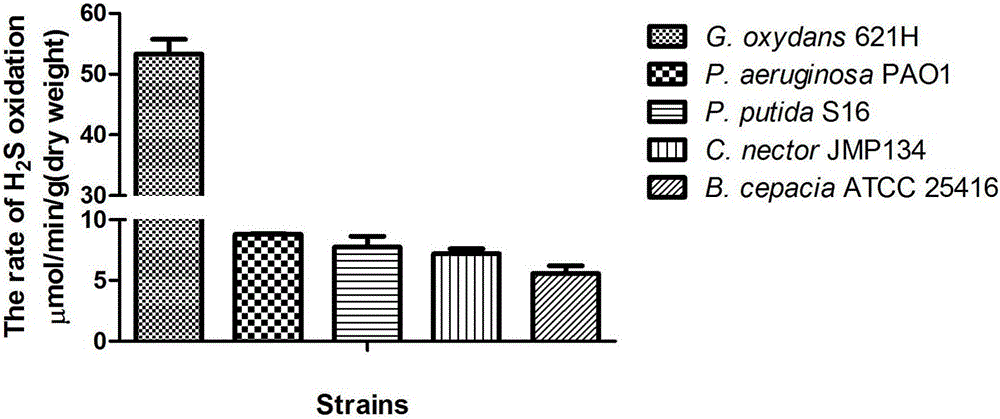Method for removing hydrogen sulfide by utilizing heterotrophic microorganisms
A technology for microorganisms and hydrogen sulfide, applied in the directions of methods using microorganisms, methods based on microorganisms, biochemical equipment and methods, etc., can solve the problems of slow growth, unfavorable hydrogen sulfide absorption and oxidation, and difficulty in forming large biomass, etc. Achieve the effect of rapid growth, convenient cultivation and efficient removal
- Summary
- Abstract
- Description
- Claims
- Application Information
AI Technical Summary
Problems solved by technology
Method used
Image
Examples
preparation example Construction
[0035] Preparation of polysulfides: 13 mg of sulfur powder and 70 mg of sodium sulfide were added to distilled water pre-deoxygenated with argon, sealed, and the pH value was adjusted to 9.3 with hydrochloric acid.
[0036] Preparation of acetone sulfur: Add excess sulfur powder into acetone, shake to dissolve fully, and the saturated solution contains about 20mM sulfur.
[0037] The detection method of sulfur disulfide is: add 0.55ml 1% boric acid to 1.5ml EP tube, heat in boiling water for 1min, add 0.25ml sample, add 0.2ml 0.1M potassium cyanide and heat for 1min, cool at room temperature, add 0.1ml Ferric nitrate reagent, mix immediately, if there are cells, remove by centrifugation, measure OD 460nm , and the blank control was deionized water.
[0038] Sulfite, sulfate and thiosulfate were detected by ion chromatography (ICS-1100system; Dionex), and the specific conditions were: mobile phase flow rate: 1ml / min, column temperature: 30°C, suppressor type: ASRS_4mm, suppres...
Embodiment 1
[0039] Example 1: Research on the hydrogen sulfide oxidation rate of five heterotrophic bacteria.
[0040] Five strains of heterotrophic bacteria (Gluconobacter oxydans 621H, Pseudomonas putida S16, Pseudomonas aeruginosa PAO1, Ralstonia (Cupriavidus necator) JMP134 , or Burkholderia cepacia (Burkholderia cepacia) ATCC25416) at 30 degrees Celsius and 200rpm shaking culture for more than 20 hours, the bacterial turbidity is greater than OD 600nm When =4, the cells were collected by centrifugation and washed once with pure water, and then the treated heterotrophic cells were dissolved in 4-(2- Hydroxyethyl)-1-piperazineethanesulfonic acid (HEPES:4-(2-hydroxyethyl)-1-piperazineethanesulfonic acid) buffer, and adjust the bacterial turbidity to OD 600 =2. In application, the cultured bacteria solution can also be used to deal with sulfide directly or after dilution.
[0041] Add 10 mL of the adjusted heterotrophic bacterial cell suspension into a 50 mL centrifuge tube, and then ...
Embodiment 2
[0045] Example 2: Research on the induction effect of hydrogen sulfide.
[0046] Ralstonia (Cupriavidus pinatubonensis) JMP134, Pseudomonas aeruginosa (Pseudomonas aeruginosa) PAO1, Burkholderia cepacia (Burkholderia cepacia) ATCC 2541, or Pseudomonas putida (Pseudomonas putida) S16 bacteria When the method in Example 1 was cultivated to the early logarithmic growth period (OD 600 =0.5), the final concentration of 20μM Na was additionally added in the medium 2 S, polysulfide or acetone sulfide, continue to cultivate and induce for 1 hour, then collect the thalline according to the method in Example 1, measure the oxidation rate of hydrogen sulfide, and compare with the control group without induction, the results show that hydrogen sulfide, polysulfide And acetone sulfur can induce bacteria to enhance their ability to oxidize hydrogen sulfide, see image 3 .
PUM
 Login to View More
Login to View More Abstract
Description
Claims
Application Information
 Login to View More
Login to View More - R&D Engineer
- R&D Manager
- IP Professional
- Industry Leading Data Capabilities
- Powerful AI technology
- Patent DNA Extraction
Browse by: Latest US Patents, China's latest patents, Technical Efficacy Thesaurus, Application Domain, Technology Topic, Popular Technical Reports.
© 2024 PatSnap. All rights reserved.Legal|Privacy policy|Modern Slavery Act Transparency Statement|Sitemap|About US| Contact US: help@patsnap.com










